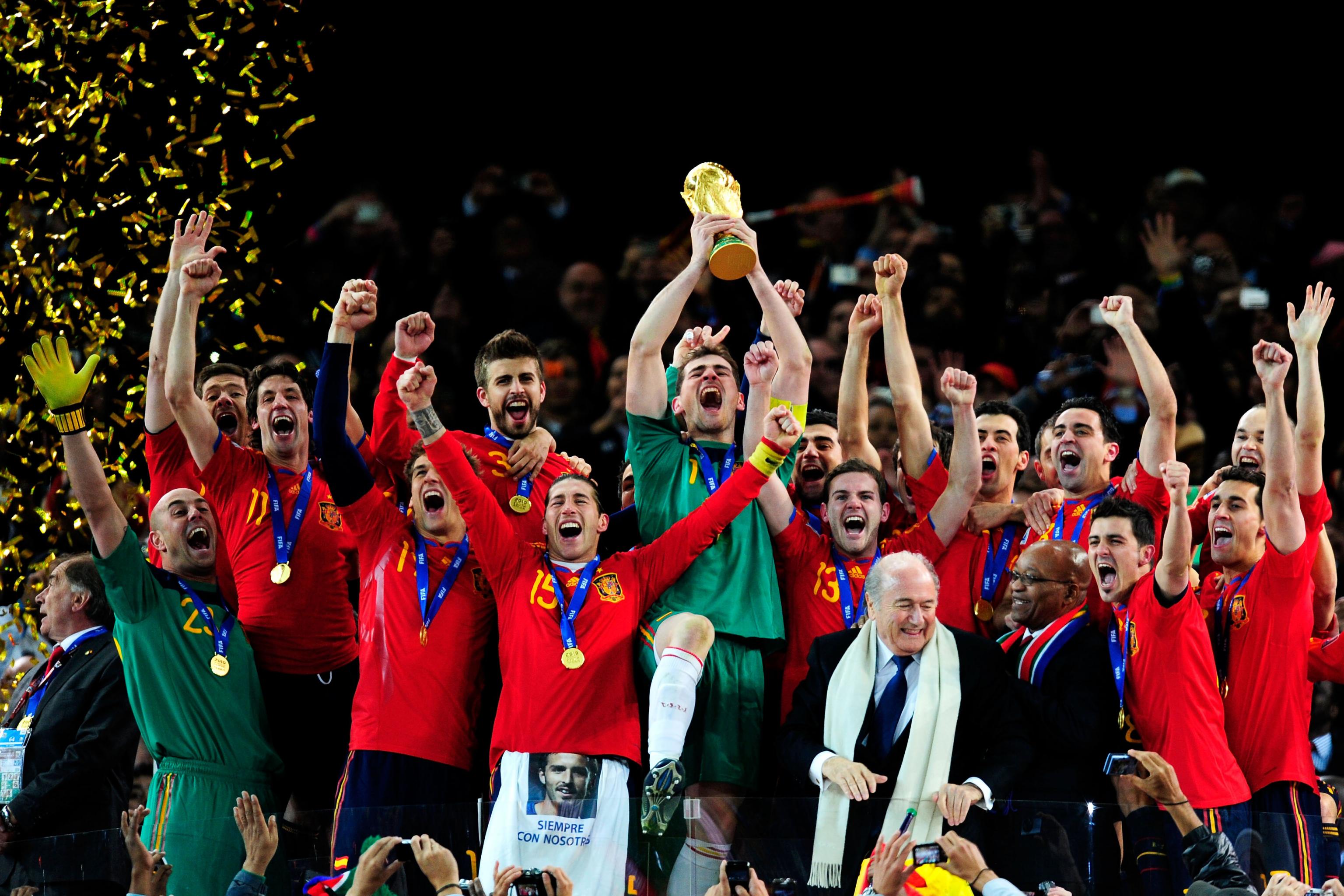“No decision will be taken before the upcoming 2014 FIFA World Cup Brazil, as agreed by the FIFA executive committee.”
Source? An official FIFA statement, via the Guardian. Topic? Whether the 2022 World Cup in Qatar will be held in the summer or winter, of course; it’s only been the topic that’s consumed most international football fans and FIFA observers in the past few months.
The timing though? Immediately after Jerome Valcke, the FIFA secretary general, suggested to a French radio station that the World Cup might be moved to November 2022 after all.
Confused? You’re not the only one. But what’s been made apparent from the Qatar World Cup 2022 debacle, is that besides all the confusion and suspicions, the focus has firmly been taken away from what the World Cup is supposed to celebrate: football, the game itself.
Sure, the talk has revolved around Qatar’s temperatures in the summer, which would make for harsh conditions for players and fans alike, but surely that would’ve been a factor in the decision-making process leading up to awarding Qatar the host rights, instead of a topic to be discussed afterwards.
That Sepp Blatter and FIFA want to bring the World Cup to the Middle East is not a secret: Back in November, he even entertained the idea of hosting the tournament across several countries in the Gulf region, according to the Telegraph. So the globalization of football and the expansion of FIFA are two key items on the agenda, and both politics and money are equally prominent at the heart of all this, as we studied in an earlier article on the World Cup controversies.
But how exactly did the World Cup get to this current state? To answer that question, let’s go back and trace the evolution of the world’s most prestigious tournament from celebration of football to money-making exercise.

The Olympics: Eternal Rival and…Founding Father?
To understand the World Cup’s evolution and growth, we must first consider the history of the Olympic Games, eternally seen as the World Cup’s rival tournament in terms of global reach and prestige.
The distinction is always made that the Olympics celebrate not just one sport, but sport as man’s pastime, while the World Cup is only the gathering of footballing nations in the world—and before the United States’ entry and strong showing, not even encompassing the entire world. The World Cup’s proponents point to the final as the premier spectacle in world sport, with no single sporting match able to match its global appeal.
In reality, while they might be rivals now and trying to outdo each other every two years, it didn’t start out that way. In fact, the World Cup has the Olympics to thank for its current iteration and success, because it was the Olympics that gave birth to the World Cup as we know it.
When FIFA was founded in 1904, international football—indeed, professional football—was a phenomenon only affordable for a few countries, and when football was inducted into the Olympic Games in the summer of 1908, only amateurs were represented. Any attempt at organizing a truly international football tournament was undermined by the lack of professional setups in most countries around the world.
But when Uruguay won both the Olympic football tournaments in 1924 and 1928, FIFA, with then president Jules Rimet as a visionary driving force, stood up, took notice, and most importantly, set about realizing his dream. The first FIFA World Cup was to be staged in 1930 in Uruguay, with politics—what else?—at the heart of the host location decision: It was to be the 100th anniversary of Uruguay’s independence, and it was to be made not a great celebration of the game itself, but a spectacular political statement.
How else to explain it, given that the Uruguay national football association was willing to cover all travel and accommodation costs incurred by participating teams? As even FIFA.com concedes, that possible profits would be shared with participants and deficits taken on by the host country won Uruguay the first ever World Cup hosting rights.
The 1934 competition was held in fascist Italy under the dictatorship of Benito Mussolini, and Rimet, according to this excellent Independent feature on his life, was already criticized for politicizing football.
Before the advent of television and the phenomenon of globalization, the World Cup had surrounded itself with politics and money.
(A footnote to add, though, is that Jules Rimet’s vision and dream of uniting the world through sport and creation of the World Cup earned him a Nobel Peace Prize nomination in 1956. Perhaps, hopefully, the World Cup at its heart was actually more than a celebration of the beautiful game, but a triumph of humanity.)
The Context: Globalization and Technology
But just as we can’t give the Olympics all the credit for introducing the concept of a FIFA World Cup, so Rimet and FIFA can’t claim all the glory for growing the tournament from a small competition featuring just a few countries in Montevideo, Uruguay, to the global spectacle that was the 2010 World Cup in South Africa.
As ever, context is key, and the explosion of global business and trade, just as it’s played a huge role in the history of the 1900s, is an integral part of the World Cup’s continued evolution. Before the business side of things took over, though, first came the phenomenon of television.
According to this TIME feature, the impact of television on the World Cup’s boom cannot be understated: From 1954 to 1986, the number of TV sets worldwide “increased more than twentyfold, from a little more than 30 million to more than 650 million.” This laid the foundations for a truly groundbreaking moment in football history.
The first live World Cup games were broadcast in Europe in the 1954 tournament, which reached only a handful of audiences due to the low volume of matches shown, but the potential of television and TV advertising was already apparent. (Not that the Olympics were to be beaten, of course: The 1936 Summer Olympics were the first to be broadcast on TV to local audiences. International broadcasts came in 1956.)
Fast forward a decade and a half. Spying an opportunity to conquer the world of football and reap the ensuing economic benefits in 1974, was new FIFA president Joao Havelange, who upon taking office turned his organization into a modern international NGO, putting in place the infrastructure, people and income-centered mindset of a corporation.
The only thing left to do for the World Cup, which previously featured 16 national teams, was to expand. And expand Havelange did, opening the doors to developing countries with eight additional slots (which have since been further increased to a total of 32 participants since France 1998), as discussed by Tim Vickery for The World Game. The Havelange era also saw the introduction of the FIFA U-17 World Cup, FIFA U-20 World Cup, FIFA Confederations Cup and FIFA Women’s World Cup.
The costs of hosting such an immense global tournament in one country were too much to bear for one host country and FIFA, and thus came the idea of corporate sponsorship of the World Cup. Havelange struck deals with Horst Dassler, heir to the Adidas fortune, for the German sportswear company and other big-name corporations like Coca-Cola to fund the tournament, paving the way for the commercialization of international football.
So while the advent of television advertising led to increased premiums for marketers to get their spots onto World Cup TV screens, behind the scenes within FIFA itself was a concerted movement to pump money into the World Cup—with political and economic influence once again the main motivation behind all these changes.
(The name Joao Havelange may be familiar. He was the same FIFA ex-president that resigned in April 2013 after a FIFA ethics report ruled that he had taken bribes, as reported by BBC Sport. The culprit in question? International Sport and Leisure [ISL], founded by Horst Dassler. Politics and money, indeed.)
The 1990s and Onwards: Spiraling Out of Control
If ever there was a curious decision in the history of world sport, the idea to host the 1994 World Cup in the US was clearly one, at the time. In hindsight, however, it was just another calculated plan from Havelange to bring the game to North American shores, which had yet to be consumed by football fever.
The legacy was stunning: To this date, USA 1994 still holds the total attendance record (over 3.5 million) and the average attendance record (68,991), according to USSoccer.com. The US’s advancement to the round of 16 for the first time since 1930 contributed to soaring TV ratings.
(Leading up to its hosting of the World Cup, the US also put in place their first ever professional soccer league. It’s no surprise that Major League Soccer was founded in 1993, a year before the 1994 World Cup. We explore the growth of soccer in the US in another article.)
The introduction of the World Cup in practically uncharted territory in 1994 was met with enormous financial successes, and since its foray into the world leader of commercialized sport and corporate sponsorship, FIFA have never looked back. The World Cup has since traveled to Asia (2002) and Africa (2010), goes to Russia in 2018, and brings us to the Middle East in 2022.
According to this Economist article, the World Cup broadcasting rights for France ’98 were sold by FIFA in 1987, before the stunning 1994 American success, for $344 million. An indication of how far the World Cup and FIFA have gone: In 1998, at the time of the article, ISL—which would later collapse, of course—had agreed to pay $2.2 billion to show the games outside America.
The groundwork for corporate sponsorship was laid by Havelange, but was taken to new levels under the leadership of current president Sepp Blatter. Let’s consider the 2010 World Cup, for example: According to a UPenn study, FIFA’s revenues related to the South Africa tournament amounted to a staggering $1.022 billion, of which $650 million belonged to broadcasting rights.
Participating national teams are in on the act too: FIFA was to provide $420 million to all participants and the football league teams providing players to the national teams, $30 million of which would go to the World Cup-winning team (Spain). First-round teams qualified automatically for $8 million each, while $1 million in preparation costs were provided to each participating football association.
This was brought about by the stellar line-up of corporate FIFA sponsors, known as “partners,” which included Adidas, Coca-Cola, Emirates Airlines, Hyundai-Kia Motors, Sony and Visa, who were “guaranteed exposure in the tournament stadium” and would receive “direct advertising and promotional opportunities and preferential access to TV advertising.”
The cost? A minimum of between 100 and million euros through to 2014. By which time, of course, the next World Cup cash cow will be held this summer, this time in Brazil.
Conclusion: It’ll Only Get More Expensive From Here
Is it damning or merely inevitable that corporate sponsorship and incessant marketing efforts are now part and parcel of any World Cup?
In the build-up to this summer’s tournament, the allegations of corruption have been brushed aside after Havelange’s resignation in 2013, while all the talk of political and commercial interests have been directed towards the distant 2022 World Cup in Qatar, still eight years away.
It’s no longer news—rather, it’s an accepted fact—that the World Cup is now considered an extremely lucrative opportunity for brands and nations alike; this Fox article on Nike and Adidas’ brand battle pre-World Cup is now just part of the fabric. In fact, any sports company—or indeed any business entity at all—would be condemned for not taking advantage of a World Cup year to promote its business.
And so it’s only going to get more expensive from here. The spending and rights associated with the premier world football tournament have skyrocketed in the past decade or so, with the help and under the influence of a few key players, but the brand-new stadiums that are to be constructed in host countries are just the tip of the iceberg when it comes to World Cup spending.
But it’s the World Cup. Just as FIFA continue to rake in the cash, we football fans will continue to ignore the commercial influences and political battles and focus on the spectacle that will unfold before our eyes when the first whistle is blown on June 12 at the Arena de Sao Paulo.
An event of this magnitude only comes once every four years, after all. When the winning team hoists the Jules Rimet trophy on July 13, for once the celebrations will be directed entirely towards the football that they have played, not the money they will make.



Read 0 Comments
Download the app for comments Get the B/R app to join the conversation